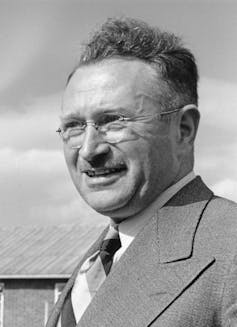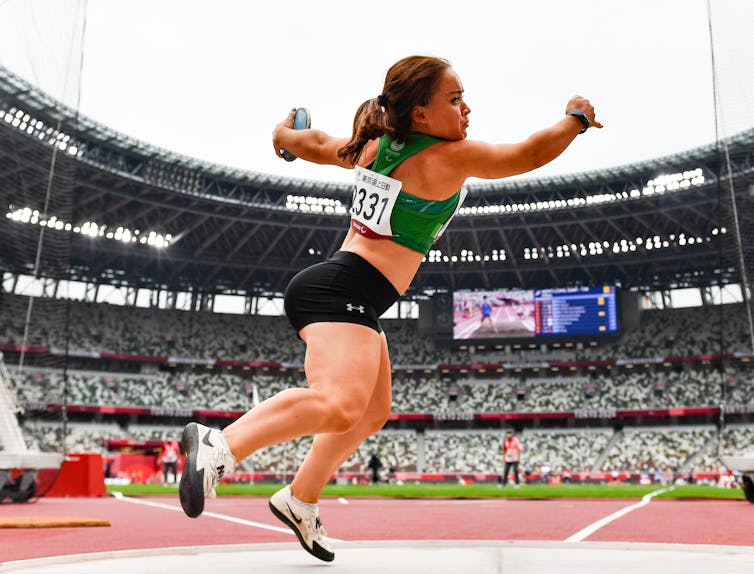When Paralympic athletes fake the extent of their disability
Parasports couldn’t exist without classifying competitors by their physical and mental limitations. But the process is far from perfect, and a handful of athletes have tried to game the system.
More than 4,000 athletes with physical, vision and intellectual impairments will compete in 22 sports during the 2024 Paralympic Games in Paris.
Within those 22 sports, there will be 549 medal events. That number seems high because several sports include multiple “sport classes,” which are used to even the playing field for athletes with different disabilities.
Some athletes compete in classes based on their specific impairment. Other classes include athletes with a range of different impairment types that result in similar degrees of “activity limitation,” as the International Paralympic Committee puts it.
For example, swimmers with physical impairments compete in categories that range from “S1” to “S10.” S indicates swimming; the number is the sport class. The lower the number, the more severe the limitation. So the S10 class might include competitors with hip restrictions, foot amputations, or cerebral palsy. They all compete in the same group because their different impairments similarly affect their swimming abilities.
The IPC sees this as akin to grouping athletes by age, gender and weight.
Despite the rigor and training that goes into the classification process, problems arise. Sport classes can be broad, putting some competitors at a disadvantage. Classification testing can be tiring or stressful for the athletes. And there can be classifier errors that put athletes in the wrong class.
Then there’s the issue of “intentional misrepresentation.” Over the years, a handful of athletes have exaggerated their impairment to gain a competitive advantage. They cheat during the classification process to improve their chances of winning against competitors who have greater limitations.
Intentional misrepresentation has been called the biggest threat to the integrity of parasports.
Building a bigger tent
As I detail in my book “Regulating Bodies,” Ludwig Guttmann, a Jewish neurologist who left Nazi Germany just before the outbreak of World War II, is considered the father of the Paralympic Games.
Guttmann established the national spinal injuries center at the Stoke Mandeville Hospital in Aylesbury, England. There, he implemented a sports program as part of the rehabilitation process for his patients.

As Guttmann later wrote, sports were “the most natural form of remedial exercise.” They also “had a psychological impact of restoring pleasure in life and contributing to social reintegration.”
In 1948, Guttmann staged the first Stoke Mandeville Games for Paraplegics, where 14 men and two women competed in archery. Initially, the Games were reserved for athletes who used wheelchairs. Over the years, the program expanded to include new sports and athletes with different impairments.
The 1976 Paralympic Games – then called the Olympiad for the Physically Disabled – introduced sports for athletes with amputations and visual impairments. Four years later, athletes diagnosed with cerebral palsy were able to compete in the 1980 Games. In 1984, organizers added “Les Autres” competitions – French for “the others” – a category that included athletes with “locomotor disabilities” such as short stature, multiple sclerosis and limb length differences. Athletes with intellectual impairments – for those with documented IQs below 75 – first participated in the 1996 Paralympic Summer Games in Atlanta.
With the addition of different impairment types, parasport organizers began to devise ways to streamline competitions while preserving fairness.
Classification was one solution.
A painstaking classification process
The current IPC Athlete Classification Code outlines a multistep classification process.
There’s a panel that includes medical classifiers – typically a physical therapist, physician, physician’s assistant or occupational therapist. There are also technical classifiers who have expertise in the sport, and can include coaches, scientists or physical educators.

Before a competition, classifiers first verify that the athlete meets the “minimum impairment criteria,” established by each sport’s international federation. This involves reviewing medical documents and detailed histories of training and performance. It might also include simple assessments of height, limb difference, muscle strength and stiffness, and range of motion.
Next, classifiers conduct a battery of sport- and impairment-specific tests to determine the athlete’s sport class. Finally, they review their decision by observing the athlete during competition. In other words, they check to make sure they got it right and that the athlete was being honest during their evaluation.
Classification is crucial. “Without it,” argues Paralympian and medical anthropologist P. David Howe, “Paralympic sport could not exist.”
Gaming the system
Despite the rigor of the classification process, intentional misrepresentation happens.
There are accounts of athletes exhausting themselves before classification so that they seem weaker than they really are. They might stiffen their muscles with cold showers, take a plunge into snow or wrap their arms and legs with overly tight bandages. Athletes might pretend to be less coordinated or weaker, fake slower reaction times or feign having poorer vision.
Perhaps the most infamous case of intentional misrepresentation involved the Spanish basketball team that won gold in the intellectual impairment class at the 2000 Paralympic Games in Sydney.
Shortly after the conclusion of the Games, a team member revealed that 10 of the 12 athletes on the team were not actually impaired. The Spanish Federation of Sportspeople with Intellectual Disabilities, he disclosed, had deliberately signed unimpaired athletes to “win medals and gain more sponsorship.” As a result, sports for athletes with intellectual impairments did not appear again on the Paralympic program until 2012.
More recently, the IPC stripped Indian discus thrower Vinod Kumar of his bronze medal in the 2020 Paralympic Games. Kumar had been assigned to the F52 class, which is for athletes in field events who compete from a seated position due to “limb deficiency, leg length difference, impaired muscle power or impaired range of movement.”
However, Kumar was observed competing with less impairment than he had shown during the classification process.
The IPC consequently suspended him from competing in the sport for two years. A second offense results in a lifetime ban.
A bad apple doesn’t spoil the bunch
It’s impossible to tell how often intentional misrepresentation happens, partly because it can be difficult to prove.
In advance of the 2016 Paralympic Games, the IPC investigated allegations against more than 80 athletes from 24 countries across six sports. In each instance, IPC officials were unable to find evidence of cheating that went beyond reasonable doubt.
It’s important to remember that most Paralympians complete the classification process with integrity. It’s like any form of cheating: Should the few athletes who do something egregious taint the entire competition?
Of course, there’s always that risk. And the complex process of classification creates opportunities.
More than anything, though, intentional misrepresentation should not deter viewers from watching some of the world’s greatest athletes. The “para” in Paralympic indicates that they run “parallel” to so-called able-bodied sports.
But a comparison to “able-bodied” doesn’t do para athletes justice; just watch a snippet of the Paralympic Games and you’ll see those bodies are more than able.
Jaime Schultz does not work for, consult, own shares in or receive funding from any company or organization that would benefit from this article, and has disclosed no relevant affiliations beyond their academic appointment.
Read These Next
From record warming to rusting rivers, 2025 Arctic Report Card shows a region transforming faster th
The 20th anniversary of the annual report tracks how sea ice, snow cover and many other vital signs…
The ‘one chatbot per child’ model for AI in classrooms conflicts with what research shows: Learning
AI tutors are often held up as an ideal, but prioritizing individualized teaching can detract from the…
Christmas trees are more expensive than ever in Colorado — what gives?
Most Christmas trees are imported from other states, which drives up costs.





